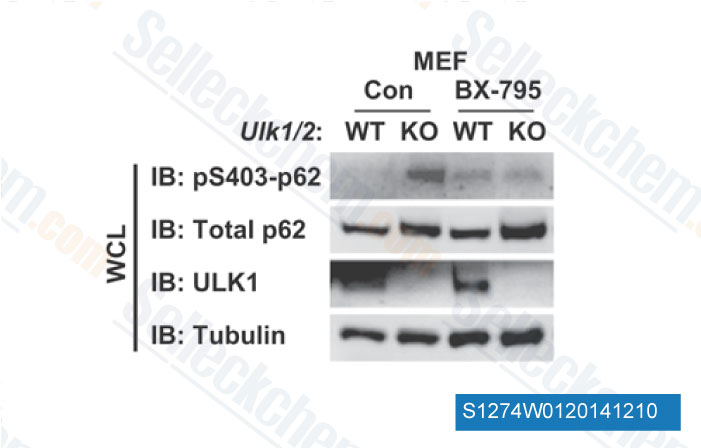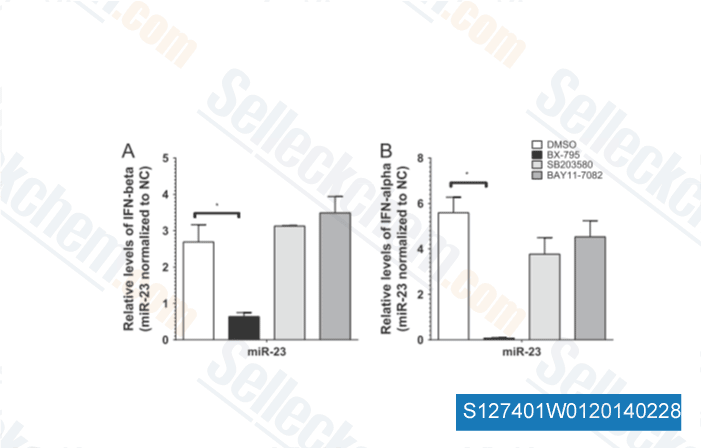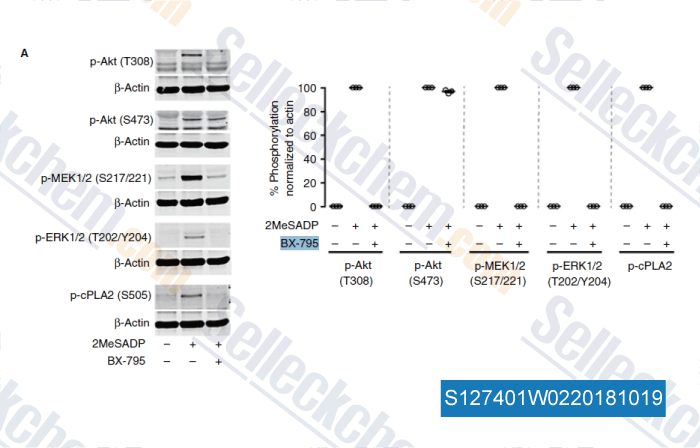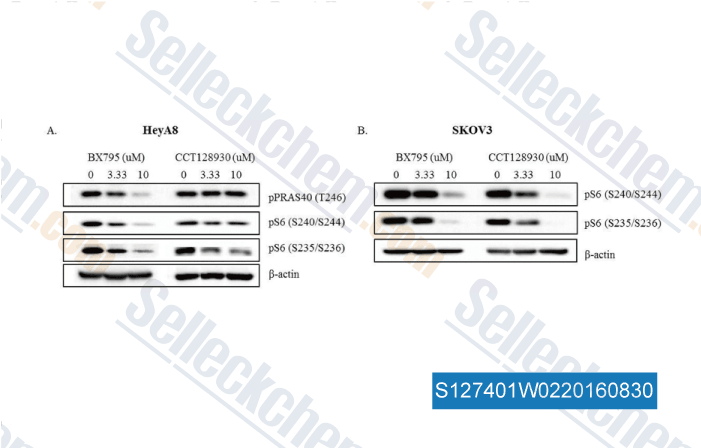|
Toll Free: (877) 796-6397 -- USA and Canada only -- |
Fax: +1-832-582-8590 Orders: +1-832-582-8158 |
Tech Support: +1-832-582-8158 Ext:3 Please provide your Order Number in the email. |
Technical Data
| Formula | C23H26IN7O2S |
|||
| Molecular Weight | 591.47 | CAS No. | 702675-74-9 | |
| Solubility (25°C)* | In vitro | DMSO | 100 mg/mL (169.07 mM) | |
| Water | Insoluble | |||
| Ethanol | Insoluble | |||
|
* <1 mg/ml means slightly soluble or insoluble. * Please note that Selleck tests the solubility of all compounds in-house, and the actual solubility may differ slightly from published values. This is normal and is due to slight batch-to-batch variations. * Room temperature shipping (Stability testing shows this product can be shipped without any cooling measures.) |
||||
Preparing Stock Solutions
Biological Activity
| Description | BX-795 is a potent and specific PDK1 inhibitor with IC50 of 6 nM, 140- and 1600-fold more selective for PDK1 than PKA and PKC in cell-free assays, respectively. Meanwhile, in comparison to GSK3β more than 100-fold selectivity observed for PDK1. BX-795 modulates autophagy via inhibiting ULK1. BX-795 also is a potent TBK1 inhibitor that blocks both TBK1 and IKKε with IC 50 values of 6 nM and 41 nM, respectively. | ||||||||
|---|---|---|---|---|---|---|---|---|---|
| Targets |
|
||||||||
| In vitro | BX-795 effectively blocks PDK1 activity in PC-3 cells, as shown by their ability to block phosphorylation of S6K1, Akt, PKCδ, and GSK3β. BX-795 potently inhibits tumor cell growth on plastic with IC50 of 1.6, 1.4, and 1.9 μM for MDA-468, HCT-116 and MiaPaca cells, respectively. In soft agar, BX-795 displays higher growth inhibition with IC50 of 0.72, and 0.25 μM for MDA-468, and PC-3 cells, respectively. [1] In addition, BX-795, as an inhibitor of the TBK1/IKKɛ, blocks TBK1- and IKKε-mediated activation of IRF3 and production of IFN-β. [2] In platelet physiological responses, BX795 produces inhibitory effect on 2-MeSADP-induced or collagen-induced aggregation, ATP secretion and thromboxane generation. [3] |
||||||||
| In vivo | BX795, a TBK-1 and PDK-1 inhibitor, also inhibits HSV protein translation. |
Protocol (from reference)
| Kinase Assay: |
|
|---|---|
| Cell Assay: |
|
References
Customer Product Validation

-
Data from [Data independently produced by FEBS J, 2014, 281(17), 3816-27]

-
Data from [Virology, 2014, 450-451, 182-95]

-
Data from [Data independently produced by , , J Thromb Haemost, 2018, 16(6):1211-1225]

-
Data from [Data independently produced by , , PLoS One, 2016, 11(5):e0155052. ]
Selleck's BX-795 has been cited by 82 publications
| TBK1-Zyxin signaling controls tumor-associated macrophage recruitment to mitigate antitumor immunity [ EMBO J, 2024, 10.1038/s44318-024-00244-9] | PubMed: 39304793 |
| Merkel cell polyomavirus protein ALTO modulates TBK1 activity to support persistent infection [ PLoS Pathog, 2024, 20(7):e1012170] | PubMed: 39074144 |
| NDV inhibited IFN-β secretion through impeding CHCHD10-mediated mitochondrial fusion to promote viral proliferation [ Vet Microbiol, 2024, 290:109973] | PubMed: 38211361 |
| HRS mediates tumor immune evasion by regulating proteostasis-associated interferon pathway activation [ Cell Rep, 2023, 10.1016/j.celrep.2023.113352] | PubMed: 37948180 |
| Circadian regulator CLOCK promotes tumor angiogenesis in glioblastoma [ Cell Rep, 2023, 42(2):112127] | PubMed: 36795563 |
| Tolerability, pharmacokinetics, and anti-herpetic activity of orally administered BX795 [ Biomed Pharmacother, 2023, 165:115056] | PubMed: 37406507 |
| Tolerability, pharmacokinetics, and anti-herpetic activity of orally administered BX795 [ Biomed Pharmacother, 2023, 165:115056] | PubMed: 37406507 |
| 3-Phosphoinositide-dependent kinase 1 drives acquired resistance to osimertinib [ Commun Biol, 2023, 6(1):509] | PubMed: 37169941 |
| AMIGO2 attenuates innate cisplatin sensitivity by suppression of GSDME-conferred pyroptosis in non-small cell lung cancer [ J Cell Mol Med, 2023, 27(16):2412-2423] | PubMed: 37438979 |
| Protective effects of activated vitamin D receptor on radiation-induced intestinal injury [ J Cell Mol Med, 2023, 27(2):246-258] | PubMed: 36579449 |
RETURN POLICY
Selleck Chemical’s Unconditional Return Policy ensures a smooth online shopping experience for our customers. If you are in any way unsatisfied with your purchase, you may return any item(s) within 7 days of receiving it. In the event of product quality issues, either protocol related or product related problems, you may return any item(s) within 365 days from the original purchase date. Please follow the instructions below when returning products.
SHIPPING AND STORAGE
Selleck products are transported at room temperature. If you receive the product at room temperature, please rest assured, the Selleck Quality Inspection Department has conducted experiments to verify that the normal temperature placement of one month will not affect the biological activity of powder products. After collecting, please store the product according to the requirements described in the datasheet. Most Selleck products are stable under the recommended conditions.
NOT FOR HUMAN, VETERINARY DIAGNOSTIC OR THERAPEUTIC USE.
